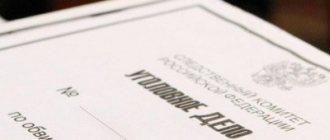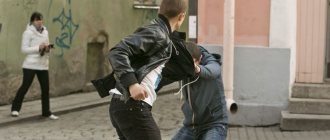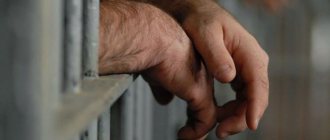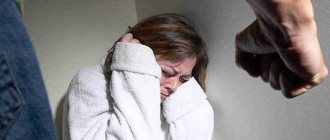A car is a source of increased danger, so operating a vehicle can lead to accidents that can result in serious injury to people.
The driver, while driving a vehicle, is responsible for the potential harm that may arise as a result of careless driving, and the degree of this responsibility is directly proportional to the severity of the damage caused to health.
Dear readers! The article talks about typical ways to resolve legal issues, but each case is individual. If you want to find out how to solve your particular problem , contact a consultant:
+7 (499) 938-81-90 (Moscow)
+7 (812) 467-32-77 (Saint Petersburg)
8 (800) 301-79-36 (Regions)
APPLICATIONS AND CALLS ARE ACCEPTED 24/7 and 7 days a week.
It's fast and FREE !
Serious consequences for the culprit of an accident can occur when people injured in an accident suffer serious harm to their health.
What it is
So what is serious harm to health in an accident? This term means harm to health, which led to the following consequences:
- Loss of performance.
- Facial disfigurement.
- Loss of an organ, loss of hearing or vision.
If, as a result of an accident, the victims are assigned a group of incapacity for work, which is limited to a time frame, then in this case the damage to health is also considered serious.
Facial disfigurement can be considered a serious consequence only if the damage is permanent.
The degree of responsibility of the perpetrator of an accident is determined by the court, and depends on many factors and conditions that can be considered aggravating or have mitigating consequences. The severity of the punishment for the culprit of the accident depends on the presence or absence of such circumstances.
What can mitigate or increase guilt?
There are many factors that can be both mitigating and aggravating.
Softening:
- The culprit has not previously been brought to administrative or criminal liability.
- The culprit was a woman who is pregnant or is the mother of minor children.
- The driver did not try to escape from the scene and provided assistance to the victim in every possible way.
- Confession, cooperation with the investigation.
- The culprit does not refuse to compensate for the damage caused to health, as well as moral damage.
This is not a complete list of mitigating circumstances, but only the most common of them.
Aggravating:
- The culprit fled the scene.
- The culprit was under the influence of alcohol or drugs.
- The driver had previously been brought to administrative or criminal liability.
By what criteria is it determined
In order to determine the severity of injuries caused by an accident, a forensic examination is ordered.
At the end of the study, a qualified decision is made on the degree of damage to the person injured in the accident.
Serious harm to health is determined by the following criteria:
- The harm caused poses a danger to life - this definition is usually understood as the danger of death during the occurrence of the incident, and some time after the accident. Even in cases where timely provision of medical care prevented death after an accident, the harm to health is still considered serious. The most frequently occurring conditions that clearly qualify as life-threatening are:
- coma;
- large blood loss;
- cerebrovascular accident, which led to collapse;
- acute pulmonary, renal or liver failure;
- purulent-septic conditions;
- circulatory disorders that led to gangrene, organ infarction or thromboembolism.
- Loss of vision to visual acuity of 0.04 or lower.
- Complete hearing loss.
- Loss of speech, which is characterized by an inability to express thoughts clearly.
- Loss of an organ. This damage can be considered a serious consequence after an accident even if the organ was not separated from the body, but its functionality was completely lost.
- If, as a result of a traffic accident, there is a need to terminate the pregnancy.
- The onset of a mental disorder - in this case, a forensic psychiatric examination is prescribed to establish the fact of a mental disorder and its relationship with the traumatic impact of an accident.
- Penetrating injury to the skull, even if the brain was not damaged.
- Penetrating injury to the spine, even in the case of an intact spinal cord.
- High severity brain contusion.
- Penetrating wounds of the abdomen and chest.
- Thermal burns, the total area of which exceeds 30% of the body surface for 2nd degree, and 15% for 3rd degree.
All of the above conditions are classified as serious harm to health. This category of damage may include loss of professional ability to work.
Unlike general work capacity, which can be limited by a third to qualify the condition as severe, professional work capacity must be limited by 100%.
Establishing the degree of harm received
Only a specialist in the process of a medical-forensic examination can establish the degree of damage and injury resulting from a collision of motor vehicles, as well as assess the general physical characteristics of the victims. It is also possible to involve third-party specialists.
First of all, specialists identify what kind of injuries the victim received and compare the information with the above list of injuries. Next, it is determined how serious the harm is and the degree of disability is determined. In particular, its persistence (by more than 30%), as well as a description of the ability to continue professional activities in the future.
In any case, the examination procedure includes a comprehensive examination of the person, examination of the outpatient card for the presence of any diseases even before the collision, and other points. Taking into account all factors, a conclusion is made, on the basis of which the court provides a final decision regarding the punishment for the at-fault driver.
Liability for grievous bodily harm in an accident
When a traffic accident occurs, the guilty party is always responsible to the state and the injured party.
If an accident occurred with the participation of a pedestrian, and the driver of the car did not violate traffic rules, then even in this case the law requires full payment of the costs of treatment of people injured in a road accident.
The culprits of a traffic accident are determined by traffic police officers, who establish the causes of the accident.
The degree of responsibility in a traffic accident and the amount of punishment are determined by the court. In addition to imprisonment and confiscation of a driver's license, the court may oblige the culprit of the accident to compensate for moral damages to the injured party.
Compensation for moral damage
In some cases, the culprit of an accident can avoid criminal punishment, but only when reconciliation is reached between the parties.
The option of a peaceful settlement is possible only with full compensation for moral damages by the culprit of the accident, as well as payment for the treatment and rehabilitation of people injured as a result of the accident.
The amount of moral damage is determined exclusively individually. The victim has the right to demand any amount of compensation under this clause, but the final amount of penalties will be determined by the court.
Criminal liability
The article of the Criminal Code of the Russian Federation for grievous bodily harm in an accident implies a very serious punishment, up to actual imprisonment.
If the court proves that the driver’s actions had malicious intent, then the punishment for such an act can be in the form of imprisonment for up to 15 years.
As a rule, road accidents occur due to inattention or due to gross violation of traffic rules.
If people died as a result of a traffic accident, then in this case the driver may end up behind bars for up to 9 years.
If there are no fatalities, but the driver does not admit his guilt, does not cooperate with the investigative authorities, or after a medical examination an increased concentration of alcohol or narcotic substances is found in his blood, then if there are no people killed as a result of the incident, a sentence of imprisonment for up to 3 years is imposed. years.
If the culprit of the accident admits the crime and cooperates with the investigation, but the accident was caused by a gross violation, then the court will impose correctional labor for up to 2 years and deprivation of the right to drive a vehicle for up to 3 years.
How moral and material damage is compensated
In accordance with current legislation, bringing to administrative or criminal liability is not a reason for evading compensation for moral or material damage.
According to Article 1064 of the Civil Code of the Russian Federation, harm caused to the person or property of a citizen, as well as harm caused to the property of a legal entity, is subject to compensation in full by the person who caused the harm.
The person who caused the harm is released from compensation for harm if he proves that the harm was not caused through his fault. The law may provide for compensation for harm even in the absence of the fault of the harm-doer.
Amount of insurance payment under compulsory motor liability insurance in connection with damage to life and health:
- in the amount of 500,000 rubles, if a fatal accident occurred, the victim received the first group of disability;
- 350,000 rubles if the victim received the second group of disability as a result of injuries received during the accident;
- 250,000 rubles when registering a disability of the third group.
The decisive factor here is the availability of valid insurance. It is clear that insurance does not always cover the amount of compensation. The maximum amount of insurance payments for the restoration of damaged vehicles is 400,000 rubles.
Moral injury
The amount of compensation for moral damage is determined by the interested party depending on the nature of the injuries received. Not only the injured persons, but also their close relatives have the right to receive compensation. If a criminal case is underway against the culprit, a civil lawsuit must be filed to obtain compensation for moral damages.
Material damage
The amount of financial compensation depends on the nature of the damage and has a specific amount prescribed by law.
How is the amount of compensation determined?
The amount of compensation is determined by the court and is calculated taking into account the following items of expenses of the injured party:
- Payment for treatment.
- Payment for travel to the place of treatment or examination.
- Payment for other paid services that are aimed at recovery after injury.
When calculating the amount of compensation, only currently current prices for medical services are taken into account. The amounts required to pay transportation costs are calculated in the same way.
If the injured party claims compensation for moral damages, then an additional amount is added to the above calculations, the amount of which depends on the degree of physical and moral suffering received by the injured party.
Statistics of deaths in road accidents in Russia in 2022 are presented in the article: statistics of road accidents in Russia for 2022. Read about estimating the cost of car repairs after an accident here.
Is the statute of limitations taken into account in this situation?
The statute of limitations for an accident depends on the degree of harm caused.
- Light - 2 years.
- Moderate severity - 6 years.
- Heavy - 10 years.
Article 208 of the Civil Code of the Russian Federation states that the statute of limitations does not apply to claims for compensation for material damage for an action that caused the victim to receive serious injuries.
| Did not find an answer to your question? Call a lawyer! Moscow: +7 (499) 755-83-41 St. Petersburg: +7 (812) 917-23-31 |
Inattention on the road or irresponsible driving can be costly for several road users. It is impossible to insure against an accident, but every motorist can reduce the risk of its occurrence.
Reconciliation of the parties
This option for resolving the conflict that has arisen is most suitable for the person responsible for the accident. Even with significant financial expenses that will be aimed at eliminating moral and physical harm, in the vast majority of cases, criminal liability does not arise.
In order to formalize the fact of reconciliation correctly, the injured party must write a receipt in free form and submit a petition to the court for reconciliation of the parties.
It is worth noting that even the presence of written confirmation of the settlement of the conflict does not always lead to the cessation of criminal prosecution.
It is impossible to try in a case where the culprit of an accident has previously had a criminal punishment. In this case, even if there is a petition from the injured party, the culprit of the accident will suffer criminal punishment.
It will not be possible to formalize reconciliation if a traffic police officer on duty was injured as a result of an accident.
Punishment for causing serious harm
As a result of the accident, the culprit takes responsibility to the country and to the people affected by his actions.
Note! Even when, as a result of an accident involving a pedestrian, the driver did not violate traffic rules, the law often requires reimbursement of the costs of medical care to the victim from him.
The culprits of the accident can first be identified by traffic police officers, who record all the facts related to it and draw up a protocol. And the judicial authorities determine the culprit and the extent of his responsibility. The court has the right not only to impose fines, but also to confiscate the driver’s license, deprive the person of liberty and order him to pay moral damages to the victim.
Causing by negligence
In our country, more than 115,000 road traffic accidents occur annually, resulting in the death or serious injury of vehicle passengers.
Even toughening administrative penalties for violating traffic rules, which lead to the most serious consequences, does not improve the accident rate.
The most common cause of death on the roads is driving into oncoming traffic, as well as violating traffic rules through negligence.
Examples from judicial practice
The driver of a Volvo car, driving along the Don federal highway, when trying to overtake a long vehicle, did not correctly calculate the distance to the oncoming car.
When entering the lane of oncoming traffic, a collision occurred with a Moskvich car, which was moving in the opposite direction.
As a result of the car collision, the driver of the Moskvich car and his passenger received serious bodily injuries, which caused temporary disability.
As a result of investigative actions, the culprit of the accident was identified. It turned out to be the driver of a Volvo car, who was not convinced of the safety of the maneuver being performed, and also did not take action to stop the vehicle in the event of an emergency.
The court, taking into account all the available evidence and the submitted petitions, sentenced the culprit of the accident. The driver of the Volvo was sentenced to 3 years in prison.
Despite the fact that the majority of road traffic accidents with severe physical damage occur outside the populated area, cases of road accidents with serious consequences are also possible within the city limits.
The driver of the Mercedes car lost control and hit a curb, as a result of which the foreign car was “thrown out” at the intersection of the road where the traffic controller was standing.
As a result of the accident, the police sergeant was seriously injured. During the investigation, it was established that the traffic accident occurred due to the fault of the driver of the Mercedes car, who exceeded the permissible speed limit, and also made multiple lane changes along the route.
Despite the fact that the driver fully admitted his guilt and cooperated with the investigation, and payments for grievous bodily harm in an accident were made in full in a pre-trial manner, the court sentenced the culprit of the accident, with a real term of imprisonment.
The driver was sentenced to 4 years, despite the victim's petition for reconciliation being submitted to the court. This outcome is most likely when it comes to the life and health of law enforcement officers.
The court in such cases always pronounces harsh sentences, and even pre-trial comparison of the parties does not exempt from criminal punishment.
The driver of a car is always responsible not only for the operation of the car while driving, but also for the cargo that is in the vehicle.
The following case from judicial practice shows how dangerous a negligent attitude towards the correct location and securing of cargo in the body of a car can be.
The driver of the Gazelle car did not secure the transported cargo in the back of the car well enough. When making sharp braking in front of a pedestrian crossing, the oak beam was thrown forward by the force of inertia, which led to injury to several people.
A citizen born in 1938 received fractures in the hip joint, which were classified by the medical commission as serious.
Other pedestrians suffered minor injuries. As a result of the investigative measures, the driver of the Gazelle car was found guilty of the accident. The court in this case passed a sentence without actual imprisonment.
The injured party submitted a motion to the court to enforce the parties. In addition, the driver had no previous convictions, and he was dependent on 2 minor children.
No alcohol or drugs were found in the blood of the person responsible for the accident.
Taking into account all mitigating circumstances, the court decided to deprive the driver of his driving privileges for a period of 3 years, and also ordered him to pay a fine of 5,000 rubles.
The state grants the right to drive a vehicle only to those citizens who have completed training in driving schools, passed exams to confirm knowledge of the rules and ability to drive a car in the traffic police, as well as those who have a medical certificate confirming the absence of diseases, the presence of which is prohibited from driving a vehicle.
In addition to rights, drivers also have obligations to comply with traffic rules, therefore, in the event of a traffic accident in which the injured party received serious harm to health, the fact of a traffic violation is first clarified.
The highest liability for such acts occurs if the driver was drunk when the accident occurred.
An aggravating circumstance may be considered to be the commission of an accident with serious consequences for health, in the case where the driver was previously deprived of the right to drive a vehicle and the period of deprivation had not expired at the time of the accident.
In all other cases, in the absence of malicious intent, the driver can count on leniency if all possible actions have been taken on his part to compensate for the moral and physical harm caused.
To whom should the receipt be given in the event of an accident, is described in the article: receipt in case of an accident. For forms and methods of accident prevention, see the page.
Find out what the consequences of an accident without insurance are from this information.
Why is the driver always to blame for an accident according to Russian law?
If you were told during driving lessons that you need to drive according to the rules, then only the one who caused the accident will be punished by law, you can forget this phrase.
There is no such thing in the Russian Federation. Partial responsibility and punishment for an accident with serious bodily injury or death always lies with the driver in whose car the passenger died, became disabled, or received other serious injuries. In the Russian Federation, there is no presumption of innocence regarding vehicle drivers. Therefore, judges carefully consider each case and try to make the most fair sentence possible. For example:
- BMW and Audi collided at an intersection.
- Both cars were damaged.
- The BMW passenger died a month later from his injuries.
- The court found both drivers guilty based on the conclusion of a forensic trace examination.
- The main blame fell on the Audi driver, but the BMW did not slow down for the required time under the STOP sign.
In any controversial situations, when it is difficult to determine which car is at fault, the driver of the vehicle in which the passenger died or was injured is responsible for the “serious” ones. The law in Russia is not ideal, so the court considers each incident individually. Absolutely everything is taken into account – right down to the purpose of the trip and what characteristics the accused driver has.






